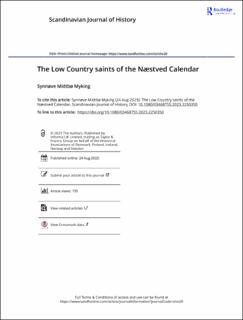| dc.contributor.author | Myking, Synnøve Midtbø | |
| dc.date.accessioned | 2023-12-28T09:42:01Z | |
| dc.date.available | 2023-12-28T09:42:01Z | |
| dc.date.created | 2023-10-12T13:25:43Z | |
| dc.date.issued | 2023 | |
| dc.identifier.issn | 0346-8755 | |
| dc.identifier.uri | https://hdl.handle.net/11250/3108970 | |
| dc.description.abstract | The Næstved Calendar (Copenhagen, Det Kongelige Bibliotek, E don. var. 52 2º), an illuminated manuscript produced at the Benedictine monastery of St Peder at Næstved (also called Skovkloster) ca. 1228–1250, is known for transmitting historical information in the form of the older Næstved annals, as well as information pertaining to various persons related to the community. However, the composition of the calendar which gives the manuscript its name has received little attention. An analysis of the feasts in the calendar reveals a strong influence from the Low Countries, more specifically the areas today covered by Belgium and Northern France, but little to none of the English and German influence usually seen as typical of high medieval Danish calendars. The article proposes two possible explanations for the calendar’s composition: the influence of the Flemish and Northern French connections of the Danish elite in the Valdemar Era (1157–1241), most famously exemplified by members of the Hvide family such as Peder Sunesen (d. 1214), and Næstved’s own contacts, forged through the town’s position as a centre of trade. In both scenarios, the saints’ presence should be seen in the context of greater mobility and increased connections with the continent in the Valdemar Era. | en_US |
| dc.language.iso | eng | en_US |
| dc.publisher | Taylor & Francis | en_US |
| dc.rights | Navngivelse 4.0 Internasjonal | * |
| dc.rights.uri | http://creativecommons.org/licenses/by/4.0/deed.no | * |
| dc.title | The low country saints of the Næstved calendar | en_US |
| dc.type | Journal article | en_US |
| dc.type | Peer reviewed | en_US |
| dc.description.version | publishedVersion | en_US |
| dc.rights.holder | Copyright 2023 The Author(s) | en_US |
| cristin.ispublished | true | |
| cristin.fulltext | original | |
| cristin.qualitycode | 2 | |
| dc.identifier.doi | 10.1080/03468755.2023.2250350 | |
| dc.identifier.cristin | 2184122 | |
| dc.source.journal | Scandinavian Journal of History | en_US |
| dc.identifier.citation | Scandinavian Journal of History. 2023 | en_US |

